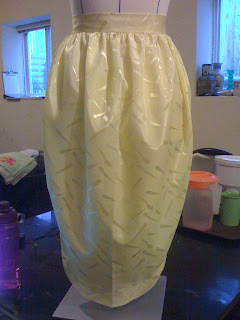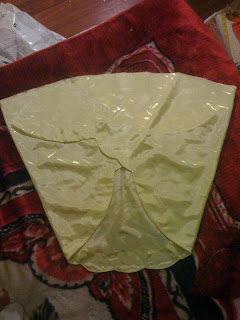I haven't actually gotten around to doing any grading work on my sloper library lately, but this weekend I figured out a way to grade both the front and back sloper sections simultaneously to save a bit of time. This is how I managed it:
First you've got to slice your sloper sections up in the required areas, then, because the sliced portions of the front and back sections have to spread apart the same amount of distance all you really need to do is group together the corresponding vertical and horizontal portions and move them to where they need to be. See below for an example:
 |
| Vertical Sections Selected For Spreading |
 |
| Horizontal Sections Selected For Spreading |
Now, when your doing any kind of patternmaking work, grading or drafting, you've got to always check things over, your measurements of everything, the 1/2" difference between the front and back sections and their armscye curve measurements, then the sleeve curve ease and the shoulder notch. All are small things, but even in computer software, if you're not using pattern maker software, you could accidentally move something or even resize something and through off all your work.
I spent the weekend tweeking my previous slopers to make sure measurements were in order, no errors or anything that could pose a problem and then got started with grading my bodice sloper and it's sleeve up to size 12. Yes, I'm still working on grading up to Butterick size 24 so I can work with some online clothing companies I want to do business with. I'm very excited getting my own patterns drafted finally. But about doing business as a designer or patternmaker, you've got to know what you're getting into and get ready for the long haul if you're not going to a complete, "you're going to learn everything" kind of fashion design course.
First of all, checking out my competition, other patternmakers don't just have portfolios and years of awesome experience with designers everyone's heard about. I've noticed patternmakers online offer a full range of services from pattern cutting, grading, sample making, marker preparation, spec sheets, the works. Basically, you want to have friends that do these things or you want to know how to do all of these things single handedly. It's tough. But, don't shy away from it if this is what you want to do, all I tell myself for example, is that it's all a matter of reading a few more books and working on these skills. That's pretty much all it takes. Never let the time something may take deter you from learning how to do something you want to do, just do it.
As both a patternmaker and hopeful designer, while doing other people's patterns and eventually drafting my own patterns so I can get boutiques to sell my designs, once the photos from their promotional campaigns start coming in, I'll have my portfolio coming together without any extra cost and what could be cooler then that? How long is this going to take?? Maybe another year or two I'm thinking, but that's fine because it'll just get me more experience under my belt and I'll develop the confidence to take my endeavors to the next step like working for a company or a couple companies as a regular staff member or service provider. :) hehehe, New York, Paris, Milan... Vancouver and Dubai here I come.
If you are interested in my discount digital pattern cutting or digitization service however, or you have any questions, please email me for more information at stylistwithacause@gmail.com or visit my Facebook page to learn more.



























